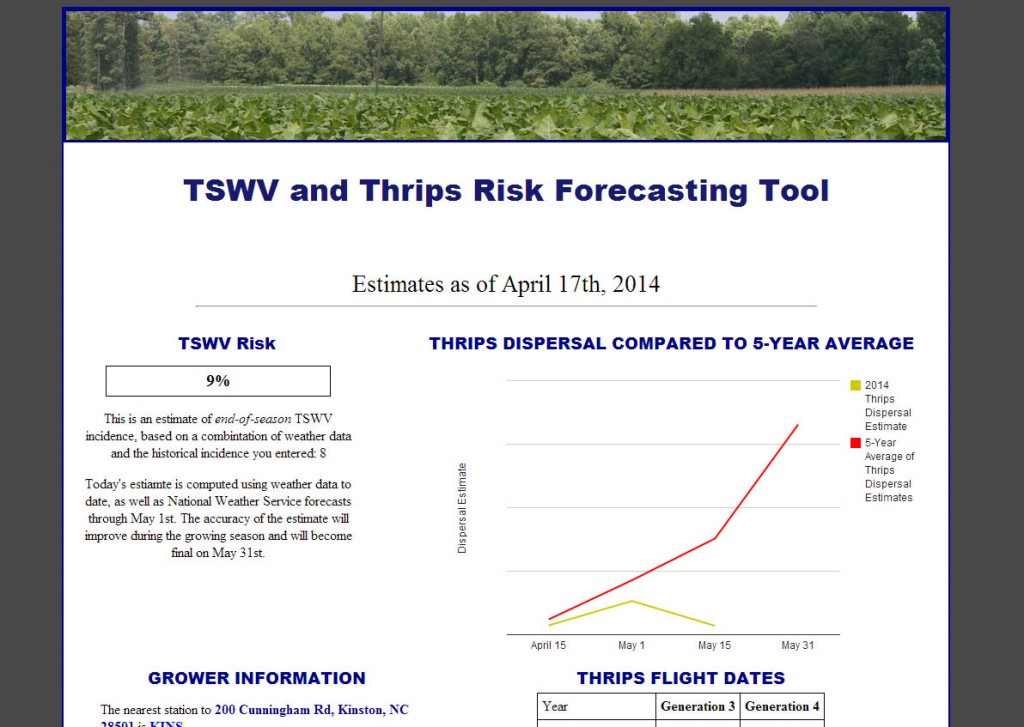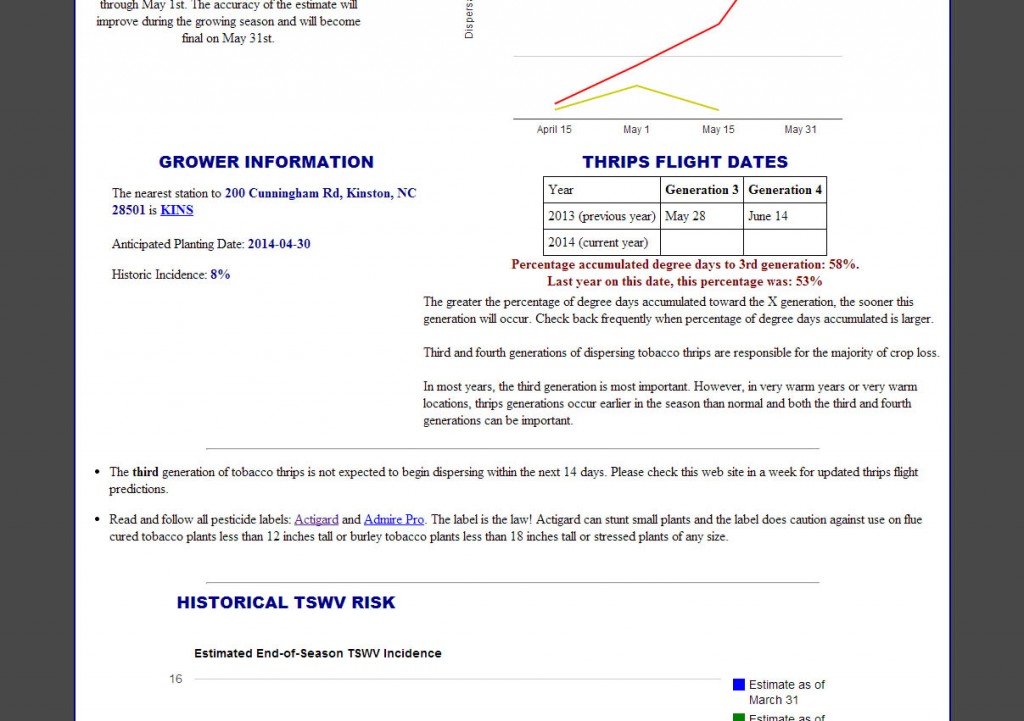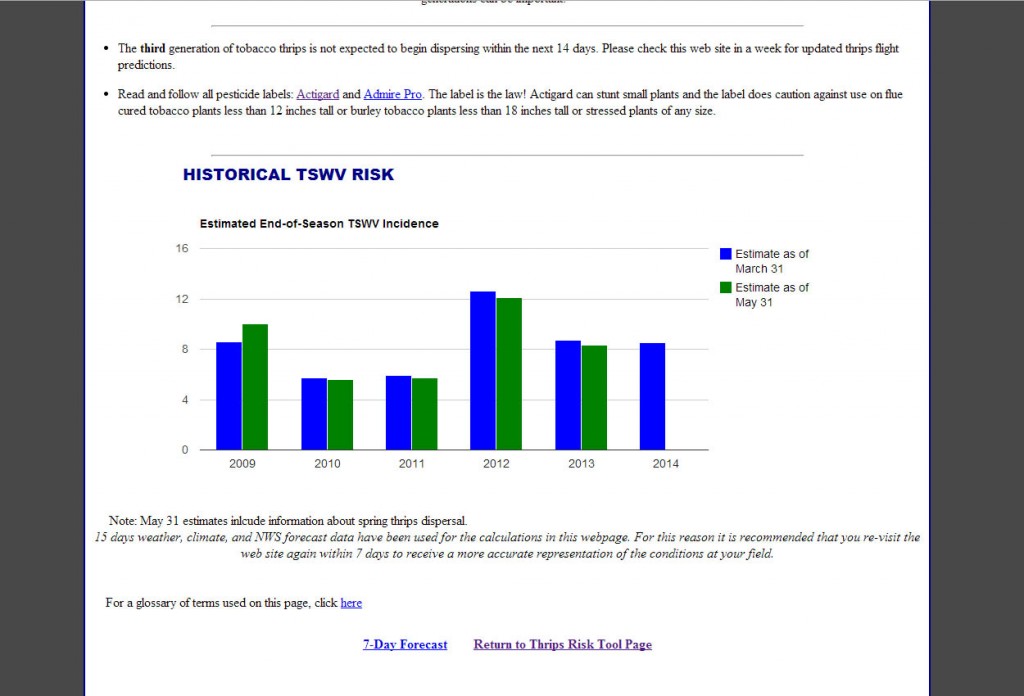Tomato Spotted Wilt Virus Risk Forecasting in Tobacco
go.ncsu.edu/readext?289553
en Español / em Português
El inglés es el idioma de control de esta página. En la medida en que haya algún conflicto entre la traducción al inglés y la traducción, el inglés prevalece.
Al hacer clic en el enlace de traducción se activa un servicio de traducción gratuito para convertir la página al español. Al igual que con cualquier traducción por Internet, la conversión no es sensible al contexto y puede que no traduzca el texto en su significado original. NC State Extension no garantiza la exactitud del texto traducido. Por favor, tenga en cuenta que algunas aplicaciones y/o servicios pueden no funcionar como se espera cuando se traducen.
Português
Inglês é o idioma de controle desta página. Na medida que haja algum conflito entre o texto original em Inglês e a tradução, o Inglês prevalece.
Ao clicar no link de tradução, um serviço gratuito de tradução será ativado para converter a página para o Português. Como em qualquer tradução pela internet, a conversão não é sensivel ao contexto e pode não ocorrer a tradução para o significado orginal. O serviço de Extensão da Carolina do Norte (NC State Extension) não garante a exatidão do texto traduzido. Por favor, observe que algumas funções ou serviços podem não funcionar como esperado após a tradução.
English
English is the controlling language of this page. To the extent there is any conflict between the English text and the translation, English controls.
Clicking on the translation link activates a free translation service to convert the page to Spanish. As with any Internet translation, the conversion is not context-sensitive and may not translate the text to its original meaning. NC State Extension does not guarantee the accuracy of the translated text. Please note that some applications and/or services may not function as expected when translated.
Collapse ▲As many part of North Carolina near transplant, now is the time when growers are also thinking about Tomato Spotted Wilt Virus (TSWV) management. TSWV is vectored by several species of thrips, and infects many species of plants, including tobacco, tomatoes, peppers, and peanuts. In North Carolina, tobacco thrips are the most significant vector of TSWV in tobacco, but additional thrips species are also significant in other crops.
TSWV management
The available TSWV managment tools are all preventative, as no tool has been demonstrated to “cure” the plant once infected. In tobacco, there three potential managment strategies: 1) Greenhouse applications of imidacloprid pretransplant, 2) Addition of Actigard® to the greenhouse float water prior transplant, and 3) foliar applications of Actigard® post transplant. Detailed information on these managment practices is available in the disease and insect management chapaters of the 2014 Flue Cured Tobacco Production Guide.
All of these management practices differ in important ways from standard grower practices, so the decision to employ them should be based on your risk of TSWV loss. Specifically, the recommended rate of imidacloprid for TSWV suppression is higher than the rate necessary to control aphids and flea beetles, and using a higher rate of imidacloprid is both more costly and increases the potential for post transplant stunting. Small plants treated with foliar applications of Actigard® also risk stunting, and the label warns against this practice. Greenhouse float water treatments of Actigard® are associated with less stunting than field foliar treatments.
TSWV risk forecasting tool
In order to help growers determine if using these management practices for TSWV is appropriate, we have developed an interactive decision aid, the TSWV Risk and Thrips Forecasting Tool, in collaboration with the NC State Climate Office.
This tool is intended for use by growers in areas at high risk of economically significant TSWV infection. TSWV is economically significant if it causes greater than 10% stand loss on average even when standard management practices are used.
At this site, you will be asked to enter the following information:
- Whether you want to assess risk for this year (available March 31-May 31) or for previous years (available anytime).
- Field location. The closer to the actual location you can enter as either an address, geographic coodinates, or a selected point on the provided map, the more accurate the model results will be.
- Anticipated planting date (optional and only available for current year assessments).
- Greenhouse treatments
- Average historic TSWV incidence for this site (this is important for determining what your risk for this year).
After you enter this information, the site will run for about one minute as it accesses the weather databases it uses to run the risk model.
The site will then output:
- Potential end of season TSWV risk for this year
- Relative numbers of dispersing thrips (or how many insects are moving around this year versus a 5-year historic average)
- When the 3rd and 4th generation of tobacco thrips are expected to become active (important for determining if a greenhouse or field treatment of Actigard® is most appropriate)
- Historic TSWV risk
I ran this model today for the Cunningham Research Station in Kinston, NC to display a typical output. This is a site where, if we do not treat tobacco with either imidacloprid or Actigard®, average TSWV infection is around 8%.
The first information displayed is end of season risk, which as of today is 9% infection in untreated plants. The infection risk displayed will depend on the historically infection percentage you entered, so if you enter data for treated plants, this number will apply to treated plants.
The line graph illustrates how many tobacco thrips are likely to be present this year (in yellow) relative to 5-year averages. You can see that this year’s thrips numbers are likely to be lower than the 5-year average.
Next, the information we entered is diplayed as well as the anticipate flight timing for the 3rd and 4th generation of tobacco thrips. Last year, we were 53% of the way to the 3rd generation of thrips at this time, and this year, we are 58% of the way there. These numbers will become more accurate the closer to the 3rd generation we are because they rely on forecast weather data! Management recommendations are only provided when the 3rd generation is 14 days or less away, so grower seeking management recommendations should check back frequently.
Finally, the site presents risk using 30-year average weather data (as of March 31st) to actual observed data (as of May 31st) to illustrate that predictions become more accurate as actual data are incorporated.
The purpose of this tool is to provide growers with an aid in determining whether they need additional intervention to manage TSWV and how best to time that intervention, but it should not necessarily take the place of the your on farm experience or local recommendations from extension specialists or agents.
We are very interested in recieving feedback on this tool and the information it provides–please do not hesitate to contact me with questions or comments.
More information
Tobacco thrips – Tobacco Growers Information Portal
2014 Flue Cured Tobacco Production Guide
TSWV Risk and Thrips Forecasting Tool – NC State Climate Office





